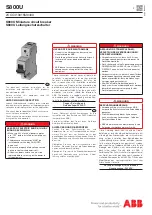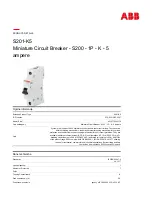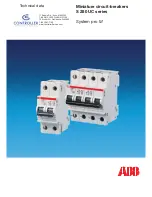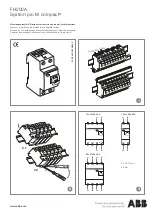
Type DK Air Circuit Breaker
Drawing
4-D-2515
shows the arrangement of adjustments on
this
tripping attachment, and curve 261560 represents the characteristic inverse
time delay.
The 100% calibration setting by the pointer on the scale plate
is the normal rating of the trip unit, and that value
of current will just
trip the breaker with no oil in the pot.
Adjustment of the thumb screw to
ward the 200% calibration setting
raises the
minimum tripping current in
minute steps as desired.
Rotation of the molded pot, properly filled with
oil as explained on the drawing,
varies the time delay between 0 and 100%.
Thus,
any desired combination
of minimum tripping
current and time de
can be selected as desired.
Drawing 4-D-2515 explains in detail the neces
sary adjustments for maintaining this overload attachment in service.
Characteristics of Thermal-Magnetic Dual Overload
The general arrangement
of this
attachment is shown on
Drawing
4-D-8316 with inverse time delay characteristics on curve 25.S872.
The 100%
calibration setting of the pointer on the scale
plate is the normal rating
of the trip unit and that value of current
will just trip the
breaker in
approximately 30 minutes or longer in a normal ambient temperature. Adjust
ment of the thumb screw toward the 150% calibration setting raises the mini
mum tripping current in minute steps as desired.
Ambient correction is explained on drawing 4-D-8316 as l% increase
in calibration for each 2oc. rise in temperature.
The attachment is cali
brated for 24oc. ambient,
but if it is
desired to
meet the
calibration
characteristics of curve 258 872 at 40°C., for instance, the calibration ad
justment should be set at approximately 108% for minimum tripping at normal
current rating.
The calibration adjustment can therefore
be set as close to the
normal running
current of the
motor as is desired,
depending on
ambient
temperature,
frequency of starting, etc.
Complete protection is thus af
forded under all conditions of operation.
Full details for
adjustment and maintenance
of the thermal-mag
netic trip attachment are explained on drawing 4-D-8316.
Replacement of Overload Attachments
Both types of overload trip units may be easily removed. From the
rear, take out two screws that fasten the magnet assembly to the main panel
and disconnect the trip unit upper
terminal where it is bolted to the main
pole unit shunt section.
In the case of drawout studs the finger cluster
and large nut must also be removed.
The trip unit may now be removed.
Re
placement is simply the reverse of this procedure.
After the unit is securely mounted to the panel, only one adjust
ment is necessary for correct operation with the breaker.
This adjustment
consists of setting the screw in the
outer end of the
trip armature lever
to properly
trip the breaker
with a thin spacer between the
armature and
magnet, as explained in both drawings 4-D-2515 and 4-D-8316.
Electric Closing Mechanism
Electrically operated DK
circuit breakers are
equipped with an
entirely self-contained
motor mechanism
mounted on the right side of
the
breaker frame. Two of the toggle linkage pins serve as dowels to accurately
locate the mechanism insulating base.
By removing three bolts,
this com
plete assembly can be taken
off the breaker
without disengaging any parts
except the wiring.
3
www
. ElectricalPartManuals
. com
Summary of Contents for DK-15
Page 13: ...w w w E l e c t r i c a l P a r t M a n u a l s c o m ...
Page 14: ...w w w E l e c t r i c a l P a r t M a n u a l s c o m ...
Page 15: ...w w w E l e c t r i c a l P a r t M a n u a l s c o m ...
Page 16: ...w w w E l e c t r i c a l P a r t M a n u a l s c o m ...
Page 24: ... w w w E l e c t r i c a l P a r t M a n u a l s c o m ...
Page 28: ...w w w E l e c t r i c a l P a r t M a n u a l s c o m ...
Page 30: ...w w w E l e c t r i c a l P a r t M a n u a l s c o m ...
Page 34: ...w w w E l e c t r i c a l P a r t M a n u a l s c o m ...
Page 36: ...w w w E l e c t r i c a l P a r t M a n u a l s c o m ...
Page 42: ...w w w E l e c t r i c a l P a r t M a n u a l s c o m ...
Page 43: ...w w w E l e c t r i c a l P a r t M a n u a l s c o m ...
Page 44: ...w w w E l e c t r i c a l P a r t M a n u a l s c o m ...
Page 52: ... w w w E l e c t r i c a l P a r t M a n u a l s c o m ...
Page 56: ...w w w E l e c t r i c a l P a r t M a n u a l s c o m ...
Page 58: ...w w w E l e c t r i c a l P a r t M a n u a l s c o m ...
Page 62: ...w w w E l e c t r i c a l P a r t M a n u a l s c o m ...
Page 64: ...I w w w E l e c t r i c a l P a r t M a n u a l s c o m ...
Page 70: ...w w w E l e c t r i c a l P a r t M a n u a l s c o m ...
Page 78: ...w w w E l e c t r i c a l P a r t M a n u a l s c o m ...
Page 82: ...w w w E l e c t r i c a l P a r t M a n u a l s c o m ...
Page 84: ...w w w E l e c t r i c a l P a r t M a n u a l s c o m ...
Page 88: ...w w w E l e c t r i c a l P a r t M a n u a l s c o m ...
Page 90: ...w w w E l e c t r i c a l P a r t M a n u a l s c o m ...
Page 96: ...w w w E l e c t r i c a l P a r t M a n u a l s c o m ...






































